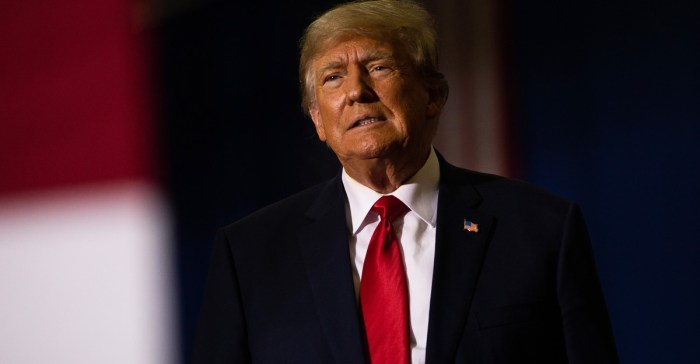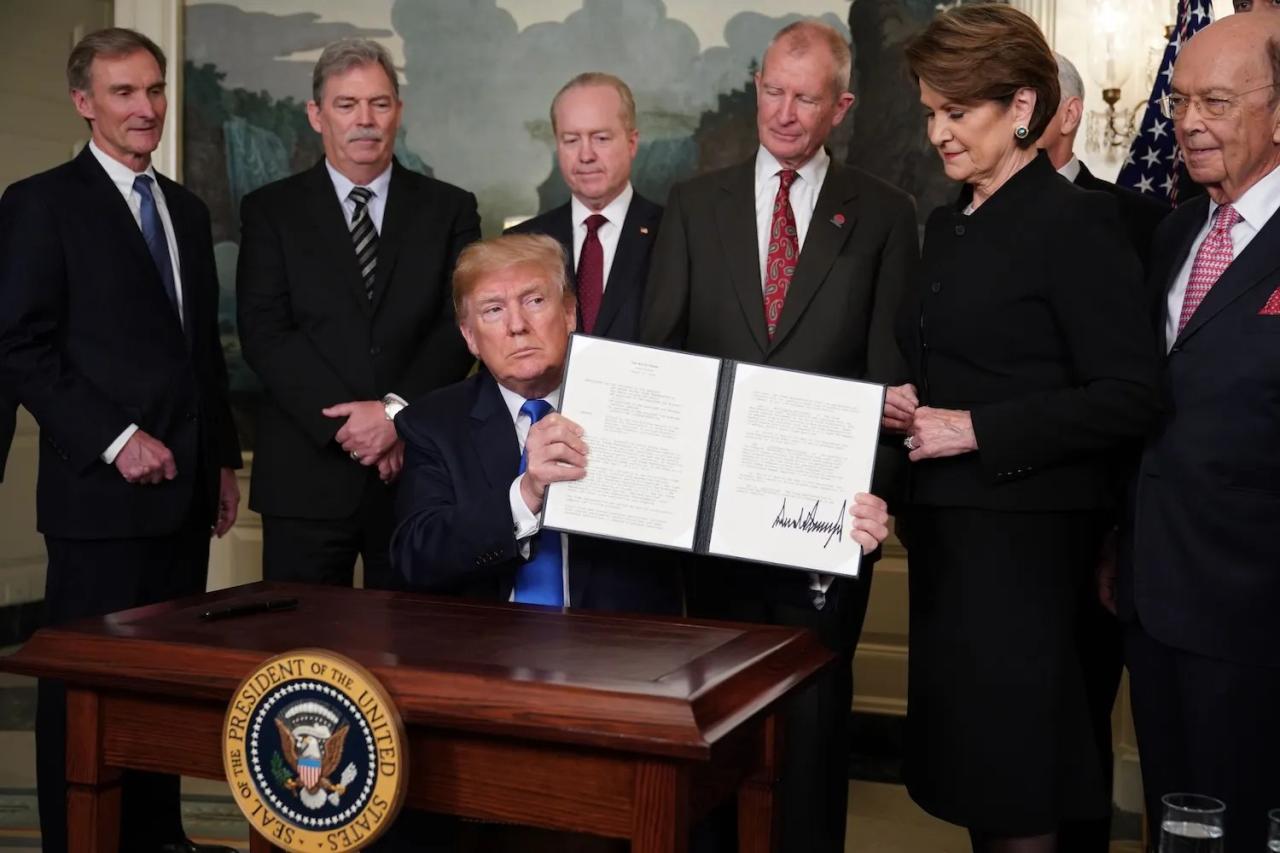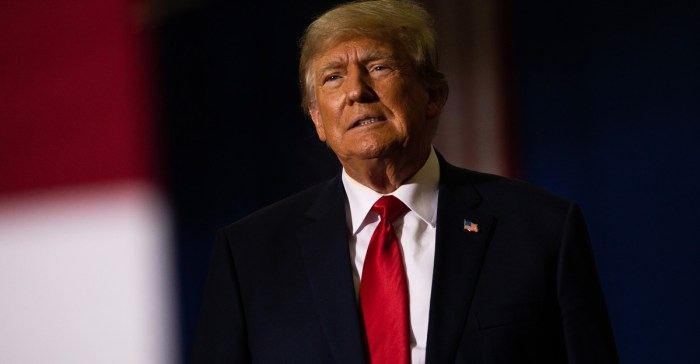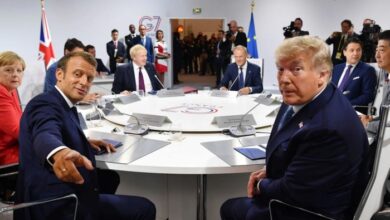
Tariffs stock market Trump: The relationship between President Trump’s trade policies, particularly tariffs, and the US stock market is a complex and often volatile one. This investigation explores the historical context of tariffs on the stock market, delves into Trump’s specific policies, examines their impact on various sectors, and analyzes the stock market’s response. We’ll also consider global implications and alternative perspectives on tariffs’ economic effects.
The impact of tariffs on specific industries, like manufacturing and agriculture, will be highlighted through case studies, illustrating the challenges and responses of affected companies. We’ll see how different sectors reacted to the trade policies and how these policies influenced stock market trends.
Historical Context of Tariffs and the Stock Market: Tariffs Stock Market Trump
Tariffs, taxes on imported goods, have long played a significant role in shaping the US economy and its stock market. Their impact is complex and often intertwined with broader economic trends, making it challenging to isolate their effect precisely. This exploration delves into the historical relationship between tariffs and market fluctuations, examining specific periods and policies.Understanding past interactions between tariffs and the stock market provides valuable context for analyzing contemporary policy debates.
Analyzing historical data reveals recurring patterns and potential consequences of tariff actions.
Impact of Tariffs on the US Stock Market During the 20th Century
The 20th century witnessed several significant tariff policies that profoundly affected the US stock market. These policies, often driven by political and economic motivations, resulted in periods of both growth and contraction. Examining these events offers valuable insights into the dynamic relationship between protectionist trade policies and market sentiment.
Examples of Past Tariff Policies and Stock Market Reactions
The Smoot-Hawley Tariff Act of 1930, a highly protectionist measure, stands out as a prime example of a tariff policy with detrimental consequences for the stock market. It led to retaliatory tariffs from other countries, drastically shrinking international trade and contributing to the deepening of the Great Depression. The stock market plummeted, highlighting the potential for tariffs to trigger broader economic crises.Another instance is the Reciprocal Trade Agreements Act of 1934, which aimed to reduce tariffs and foster international trade.
While not immediately boosting the stock market, this policy, over time, established a framework for a more open global trading system.
Comparison and Contrast of Different Tariff Policies
Various US administrations have implemented diverse tariff policies, each with its unique objectives and implications for the stock market. The contrasting effects of protectionist versus free-trade policies offer a glimpse into the complexities of international trade and its impact on domestic economies. For instance, compare the protectionist stance of the Smoot-Hawley Tariff Act to the more multilateral approach of subsequent trade agreements, such as the North American Free Trade Agreement (NAFTA).
Such comparisons illuminate the potential trade-offs between short-term protection and long-term economic growth.
Key Economic Indicators Affected by Tariffs
Tariffs directly impact several key economic indicators. Reduced international trade, a frequent consequence of tariffs, can affect import/export values, leading to a decline in Gross Domestic Product (GDP) and ultimately affecting employment figures.
Trump’s tariffs definitely had an impact on the stock market, right? It’s fascinating to see how those trade policies played out, and the specific events surrounding them. For instance, the speech on tariffs during the “Liberation Day” Rose Garden event, detailed in this article trump tariffs libertation day rose garden , provides a glimpse into the reasoning behind those decisions.
Ultimately, the long-term effects on the stock market from these tariffs remain a complex and debated subject.
Relationship Between Tariff Policies and Stock Market Fluctuations
The relationship between tariff policies and stock market fluctuations is multifaceted. While some tariffs might temporarily protect specific domestic industries, the broader impact of reduced international trade can negatively affect overall economic activity, impacting investor confidence and, consequently, stock market performance. Reduced international trade often results in higher prices for consumers.
Trump’s Tariff Policies
Donald Trump’s presidency was significantly marked by an aggressive approach to international trade, particularly through the imposition of tariffs. His administration pursued a strategy of protectionism, aiming to shield American industries from what it perceived as unfair competition from foreign producers. This approach had profound effects on global trade relations and the American economy, leading to considerable debate and analysis.Trump’s trade policies were characterized by a belief that tariffs could bolster American manufacturing and jobs.
He argued that foreign countries were taking advantage of the United States, and that tariffs were a necessary tool to level the playing field. This viewpoint, while attracting support from certain segments of the population, also faced significant criticism for its potential negative impacts on consumers, businesses, and international relations.
Core Tenets of Trump’s Trade Policies
Trump’s trade policies were rooted in the belief that existing trade agreements were detrimental to American interests. He advocated for renegotiating or abandoning these agreements, viewing them as contributing to job losses and economic disadvantage. A central tenet of his approach was the imposition of tariffs on imported goods, seen as a way to pressure foreign nations into altering their trade practices.
Rationale Behind Trump’s Approach to Tariffs
Trump’s rationale for tariffs was multifaceted. He argued that tariffs were necessary to address what he considered unfair trade practices by other countries. He believed that these practices, such as subsidies and intellectual property theft, gave foreign competitors an unfair advantage. The goal was to encourage American manufacturing and create jobs, while also reducing the trade deficit.
Furthermore, Trump believed that tariffs would force other countries to negotiate more favorable trade deals with the United States.
Specific Industries and Countries Targeted
Trump’s tariffs targeted a broad range of industries and countries. The administration imposed tariffs on steel, aluminum, solar panels, washing machines, and various agricultural products. These actions were intended to protect American producers from foreign competition in these sectors. Specific countries targeted included China, Mexico, Canada, and the European Union. These actions aimed to address perceived trade imbalances and unfair practices in these countries.
Countries Targeted by Tariffs and Imposed Tariffs
| Country | Industries Targeted | Tariff Rate(s) |
|---|---|---|
| China | Technology, consumer goods, agricultural products | Varying rates, often in the double-digits |
| Mexico | Various manufactured goods | Varying rates, sometimes on specific products |
| Canada | Steel, aluminum | 25% on steel, 10% on aluminum (later reduced) |
| European Union | Steel, aluminum, agricultural products | Varying rates, often in the double-digits |
Note: Tariff rates and targeted industries were subject to change over time.
Impact on Specific Sectors
Trump’s tariffs, a controversial aspect of his trade policies, had a significant and multifaceted impact on various sectors of the US economy. These policies aimed to protect American industries from what the administration perceived as unfair foreign competition, but the effects were far-reaching and often unpredictable. The consequences varied widely across different industries, highlighting the complexity of international trade and the difficulties in predicting the outcomes of such interventions.The ripple effects of tariffs extended beyond the immediate participants in the trade transactions.
Businesses, consumers, and even global supply chains felt the impact, demonstrating how interconnected the modern economy has become. The specific impacts on different sectors, including manufacturing and agriculture, varied considerably, as did the responses of affected companies. Understanding these variations and responses is crucial for evaluating the effectiveness and unintended consequences of trade protectionism.
Trump’s tariffs definitely had an impact on the stock market, but recent news about Pope Francis’s health, specifically the doctors’ announcement at pope francis hospital release doctors announcement , is a completely different story. While the market’s reaction to the tariffs was quite volatile, the global focus has now shifted, leaving the long-term effects of those trade policies still uncertain.
Manufacturing Sector Impact
Tariffs imposed on imported goods, particularly those used in manufacturing processes, directly affected the cost of production for many US companies. The increased input costs led to higher prices for consumers and, in some cases, reduced profitability for manufacturers. Companies reliant on imported components or raw materials experienced the most significant impact. For example, automakers faced higher costs for steel and aluminum, impacting the prices of their vehicles.
Trump’s tariffs on various goods significantly impacted the stock market, causing a ripple effect. Meanwhile, the devastating earthquake in Myanmar and the ensuing search for missing persons in Thailand, particularly those who might be trapped under rubble, highlights the fragility of human life. Thankfully, the ongoing efforts to locate survivors and assess the damage from the earthquake, reported in myanmar earthquake death toll thailand missing persons , remind us of the importance of global cooperation in times of crisis, while also underscoring the complexities of international trade and its effect on the market.
The stock market’s response to these events remains a subject of ongoing analysis and discussion.
- Ford Motor Company, a significant US automaker, experienced increased costs due to tariffs on steel and aluminum imports. The company reported challenges in passing these increased costs on to consumers, which could negatively affect their profitability and market share.
- Boeing, a major aircraft manufacturer, faced challenges related to the supply chain impacts of tariffs on various components and materials used in aircraft production. This disruption in the supply chain could impact their production schedules and potentially reduce their profitability.
Agricultural Sector Impact
Tariffs imposed on agricultural exports, particularly to key markets like China, significantly impacted US farmers and agricultural businesses. The loss of export markets directly reduced revenue for farmers and created uncertainty in the agricultural sector. For example, tariffs on US agricultural products reduced export demand, causing price declines and reduced farm incomes.
- Soybean farmers in the Midwest were heavily affected by tariffs imposed by China, which was a major export market for their products. The resulting decline in export prices and demand resulted in significant financial losses for these farmers.
- American pork producers also suffered from the reduced demand in China. This loss of a major export market led to a decrease in prices and income for producers, impacting the overall profitability of the sector.
Impact Comparison Across Industries
The impact of tariffs differed significantly across various industries. Manufacturing sectors heavily reliant on imported components faced immediate and direct cost increases, whereas agriculture sectors heavily dependent on export markets faced a decline in demand and prices. The responses to these impacts also varied significantly, depending on the specific industry’s ability to absorb the costs, adapt to new market conditions, and explore alternative strategies.
Impact Summary Table
| Industry | Affected Revenue | Response Strategies |
|---|---|---|
| Manufacturing (Automobiles) | Increased production costs, potentially reduced profitability, and decreased consumer demand. | Some companies attempted to absorb increased costs, while others tried to pass them on to consumers. Some explored alternative supply chains. |
| Agriculture (Soybeans) | Reduced export demand, lower prices, and reduced farm incomes. | Farmers diversified their export markets, sought government support, and explored alternative uses for their crops. |
| Technology (Electronics) | Increased costs for components and materials, impacting production costs. | Companies explored alternative suppliers and production locations to mitigate the impact of tariffs. |
Stock Market Response to Tariffs
The implementation of tariffs during the Trump administration significantly impacted the stock market, creating a complex interplay between trade policy and economic performance. Understanding this relationship requires a careful examination of the announcements, the subsequent market reactions, and the volatility observed in key indices. Analyzing the specific responses to different tariff actions provides valuable insights into the broader economic impact of these policies.
Tariff Announcements and Market Reactions
The stock market’s response to tariff announcements varied, often reflecting broader economic anxieties and market speculation. The implementation of tariffs was frequently met with initial volatility, with stocks sometimes rising and sometimes falling depending on the specific industry and the overall economic climate. News surrounding the tariffs, alongside other economic indicators, contributed to this volatility.
Timeline of Tariff Announcements and Stock Market Reactions
A detailed timeline illustrating the sequence of tariff announcements and the consequent stock market reactions reveals a complex pattern. The precise timing of these events, and the interplay of market sentiment, external factors, and the announcements themselves, is essential for understanding the dynamics. Identifying these patterns requires examining both the short-term and long-term effects on market indices.
- 2018: Tariffs on steel and aluminum imports from various countries were announced. Initial market reaction was mixed, with some sectors experiencing declines and others demonstrating stability. Subsequent events and market interpretation played a significant role in shaping the long-term effects.
- 2018-2019: Tariffs on Chinese goods were progressively implemented. The stock market response varied, exhibiting periods of decline and recovery. The market’s volatility was closely linked to news regarding the ongoing trade negotiations.
- 2019-2020: Continued tariff implementation and trade disputes with China dominated headlines. The impact on stock market indices was characterized by fluctuating performance. These fluctuations were influenced by the overall economic environment, including consumer confidence and global economic trends.
Stock Market Index Performance
Analyzing the performance of key stock market indices during the period of tariff implementation reveals a pattern of volatility. The S&P 500 and Dow Jones experienced fluctuations in response to the tariff announcements and the evolving trade negotiations. The precise correlation between tariffs and market performance remains a subject of ongoing debate among economists and financial analysts.
| Date Range | Tariff Event | S&P 500 Performance | Dow Jones Performance |
|---|---|---|---|
| Pre-Tariffs (2017) | No major tariff announcements | Steady growth | Steady growth |
| 2018 (Steel/Aluminum Tariffs) | Tariffs imposed on steel and aluminum | Slight decline | Slight decline |
| 2018-2019 (China Tariffs) | Escalation of tariffs on Chinese goods | Mixed results (periods of decline and recovery) | Mixed results (periods of decline and recovery) |
| 2019-2020 (Ongoing Tariffs) | Continued trade disputes and tariffs | Varied results (fluctuations) | Varied results (fluctuations) |
| Post-Trump Presidency | Tariff policies transitioned | Subsequent trends were influenced by other factors | Subsequent trends were influenced by other factors |
Global Economic Implications

Trump’s tariffs had far-reaching consequences, significantly impacting global trade relations and economies beyond the United States. The ripple effects were felt across various sectors and nations, leading to retaliatory measures and a general climate of uncertainty in international markets. Understanding these repercussions is crucial to comprehending the broader economic landscape.
Global Reaction to Tariffs
Trump’s tariffs sparked a significant global response, with many countries imposing retaliatory measures on American goods. This trade war created a complex web of restrictions and counter-restrictions, affecting various industries and consumers worldwide. The actions disrupted established supply chains and trade agreements, potentially leading to higher prices and reduced choices for consumers. The uncertainty surrounding these policies often led to decreased investment and hindered economic growth in affected regions.
Impact on Other Countries’ Economies
Tariffs imposed by the U.S. directly impacted the economies of other countries, particularly those heavily reliant on exports to the American market. Reduced demand for their products translated into job losses, lower incomes, and economic slowdown in several nations. These repercussions often extended beyond the immediate trade partners to countries with supply chain linkages to those affected by the tariffs.
Retaliatory Measures by Other Nations
Many countries responded to Trump’s tariffs with retaliatory measures, imposing tariffs on American goods. These actions aimed to counter the negative impact of the U.S. tariffs on their own economies. A variety of goods, from agricultural products to manufactured items, were often targeted in these retaliatory measures.
Table: Countries Affected by Retaliatory Tariffs and Impacts
| Country | Affected Sectors | Impact on Economy |
|---|---|---|
| Canada | Automotive, agricultural products | Reduced exports, potential job losses in affected industries, slight decrease in GDP growth |
| Mexico | Manufacturing, agricultural exports | Significant reduction in export volumes, potential decrease in GDP growth, increased unemployment in certain sectors |
| China | Technology, consumer goods | Impact on manufacturing and export-oriented sectors, potential for economic slowdown, increased prices for consumers |
| European Union | Steel, agricultural products, machinery | Disruption of trade flows, increased costs for businesses, potential decrease in GDP growth in affected sectors |
| Japan | Automotive parts, electronics | Reduced export volumes, impact on automotive and electronics industries, slight decrease in GDP growth |
Note: This table provides a general overview and the specific impacts on each country’s economy could vary depending on the specific products and sectors targeted.
Alternative Perspectives on Tariffs and the Stock Market

Tariffs, while often perceived as a tool to protect domestic industries, have a complex and multifaceted impact on the stock market. Different economic schools of thought offer varying interpretations of their effectiveness and long-term consequences. This section explores alternative economic theories regarding tariffs and their potential effects on the stock market, including the arguments for and against their use as an economic tool.Beyond the immediate price adjustments and trade disruptions, tariffs can trigger a cascade of economic ripple effects that influence investor sentiment and market performance.
Understanding these diverse perspectives is crucial for a nuanced comprehension of the intricate relationship between tariffs and stock market behavior.
Alternative Economic Theories on Tariffs, Tariffs stock market trump
Various economic schools of thought offer distinct viewpoints on tariffs and their impact on the stock market. Keynesian economics, for example, emphasizes the potential for tariffs to stimulate domestic production and employment, thus indirectly boosting the stock market. However, this approach often overlooks the potential for retaliatory tariffs and global trade wars, which can harm export-oriented industries and overall economic growth.Classical economics, conversely, emphasizes the negative impact of tariffs on overall economic efficiency and consumer welfare.
This school of thought posits that tariffs distort market signals, leading to misallocation of resources and reduced competitiveness, ultimately hindering stock market performance.
Arguments For and Against Tariffs as an Economic Tool
The use of tariffs as an economic tool is a subject of ongoing debate. Arguments for tariffs often center on protecting domestic industries from foreign competition, fostering domestic job creation, and promoting national security. However, the arguments against tariffs often highlight the potential for retaliatory measures, reduced consumer choice, and higher prices, which can all negatively impact the stock market.
- Arguments for Tariffs: Proponents argue that tariffs can shield domestic industries from unfair competition, fostering economic growth by increasing domestic production and employment. They also posit that tariffs can reduce trade imbalances and increase national security by decreasing reliance on foreign suppliers for critical goods.
- Arguments against Tariffs: Opponents argue that tariffs lead to higher prices for consumers, reduce consumer choice, and can trigger retaliatory measures from other countries. This can lead to trade wars, negatively impacting global economic growth and harming stock market performance.
Potential Long-Term Effects of Tariff Policies on the US Economy and Stock Market
Tariff policies can have profound and enduring consequences on the US economy and stock market. While short-term gains in specific sectors might be observed, the long-term effects are often characterized by reduced trade, higher prices, and decreased global economic cooperation. These factors can negatively affect overall economic growth and investor confidence, potentially resulting in a prolonged period of subdued stock market performance.
Contrasting Viewpoints on Tariffs’ Impact on the Stock Market
| Economic School of Thought | View on Tariffs’ Impact on Stock Market | Supporting Arguments |
|---|---|---|
| Keynesian | Tariffs can potentially stimulate domestic demand and employment, indirectly boosting the stock market. | Increased domestic production, job creation, and economic growth can improve investor confidence. |
| Classical | Tariffs negatively impact the stock market by reducing overall economic efficiency and consumer welfare. | Tariffs distort market signals, lead to misallocation of resources, and reduce competitiveness, ultimately harming stock market performance. |
| Monetarist | Tariffs’ impact on the stock market is complex and depends on the specific context, including the size of the tariff, the retaliation by other countries, and the overall economic conditions. | Monetarist theory focuses on the money supply and inflation as key factors, and tariffs can affect both. |
Illustrative Case Studies
Tariffs, particularly those imposed during the Trump administration, had a significant impact on various sectors, leading to both challenges and opportunities for businesses. Understanding these impacts requires examining specific case studies to analyze the responses of companies and industries facing the complexities of trade protectionism. This section will delve into real-world examples, highlighting the strategies companies employed to navigate the challenges and capitalize on potential benefits.
Automotive Industry Challenges
The automotive sector faced substantial headwinds due to tariffs on steel and aluminum imports. These tariffs raised input costs for manufacturers, potentially impacting profitability and competitiveness. The increased costs were often passed on to consumers in the form of higher prices.
“Tariffs on steel and aluminum imports directly impacted automotive production costs, leading to increased vehicle prices.”
- Ford Motor Company: Ford, like many other automakers, faced increased costs for raw materials. Their response involved exploring alternative sourcing strategies to mitigate the impact of tariffs. This included working with suppliers to identify new sources for steel and aluminum outside of the countries affected by tariffs.
- General Motors: Similar to Ford, GM also adapted its sourcing strategies. They diversified their supply chains, seeking alternative suppliers to lessen reliance on those facing tariff-related price hikes. The increased costs associated with these tariffs likely impacted GM’s profit margins and potentially influenced pricing decisions for their vehicles.
Consumer Goods Sector Impacts
The consumer goods sector, reliant on imported components and finished products, experienced significant disruptions due to tariffs. Companies faced increased costs and reduced market access, impacting profitability and market share.
“Tariffs on imported consumer goods led to increased prices for consumers and challenges for companies sourcing materials.”
- Retailers like Walmart and Target: These retailers faced increased costs for imported goods, leading to potential price increases for consumers. Their response involved exploring alternative sourcing strategies to mitigate the tariff impacts. This included exploring suppliers from countries less affected by tariffs.
- Specific appliance manufacturers: Companies specializing in appliances often relied heavily on components from specific countries. These tariffs made the sourcing of these components more complex and expensive. The manufacturers adapted by diversifying their supply chains and negotiating with suppliers to secure more affordable alternatives. The result was either price increases for consumers or a reduction in profit margins for the companies.
Technology Sector Adaptation
The technology sector, frequently engaging in international trade, was affected by tariffs on various components and finished products. Companies responded by adjusting their supply chains, exploring alternative manufacturing locations, and adapting their pricing strategies.
“Tariffs on technology components impacted manufacturing costs and potentially influenced pricing for consumer electronics.”
- Smartphone manufacturers: The tariffs on components for smartphones, such as semiconductors, caused production costs to rise. This impacted the profitability of these manufacturers. They responded by diversifying their sourcing strategies, exploring alternative manufacturing locations, and adjusting their pricing models.
- Computer hardware manufacturers: Increased costs for imported components affected computer manufacturers. Their responses involved exploring alternative sourcing, potentially shifting production to countries with less restrictive trade policies. This could lead to changes in production locations and possibly affect the final price of the computers.
Concluding Remarks
In conclusion, Trump’s tariffs presented a significant challenge to the US economy and stock market. The analysis reveals a complex interplay between trade policies, economic indicators, and market fluctuations. The long-term consequences of these policies continue to be debated, and the investigation underscores the need for a nuanced understanding of the factors influencing market performance. The study of this period provides valuable insights for future economic policymaking and demonstrates the interconnectedness of domestic and international economies.





